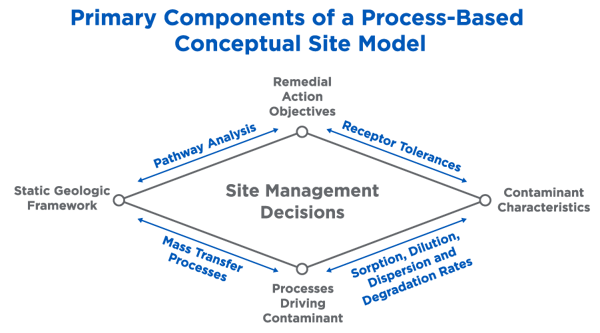Surprises, inefficiencies, data that “just doesn’t fit,” and remediation timelines with no end in sight most often occur at complex contaminated sites where the processes at work are not understood.
While it might be difficult to visualize, a groundwater remediation site is dynamic, featuring a combination of physical, chemical and microbial processes acting simultaneously and in series, evolving toward some future state. Ideally, from a remediation perspective, this future state would be one similar to the natural conditions that existed before the system was impacted with a contaminant of concern. However, it is more realistic that we seek to attain a steady state in which risk to human and ecological receptors is minimized and the associated regulatory criteria for site closure are met with certainty and in a timely fashion.
Understanding site data from the perspective of the processes at work allows site management to transition from a descriptive and reactive stance to a predictive, prescriptive and proactive one. This mindful shift is transformative, empowering all stakeholders to actively work toward a solution rather than simply respond to a problem.
Site assessment and monitoring data collected to understand contaminant distribution, groundwater flow, or as a metric of remediation efficacy are a single realization of the dynamic and variable site conditions — a snapshot in time. With enough snapshots of conditions over a long enough time frame, an empirical understanding of a site’s evolution might be possible; when synthesized, the results can provide a descriptive conceptual framework for future work. However, this is an inherently passive approach to site conceptualization.
By investing time and targeting high-quality data collection to quantify and understand the processes at work that control and produce the results measured in the descriptive data snapshots, remediation can be optimized, uncertainty can be minimized and the ability to predict future results can be strengthened. Thus, process-based thinking and process-based conceptual site models (CSMs) pay significant dividends for complex contaminated sites by expediting the remediation process, focusing resources, and adding confidence and certainty to the decision-making process.
PROGRESS — Progressive Remediation Strategies — emphasizes cross-discipline data analysis and integration to create process-based CSMs as a matter of standard practice. This allows project teams and stakeholders to accurately understand, quantify and leverage the key processes driving remediation performance to predict outcomes and increase efficiency.
I have a CSM. How is a process-based CSM approach different?
Environmental Protection Agency (EPA) and ASTM International guidance and advocacy have made CSM development a best practice in the remediation industry (EPA 542-F-11-011 and ASTM E2531-06). Further, they have defined the current paradigm in which CSMs are largely descriptive in nature and evolve as needed to address risk and the remedial actions required. ASTM International advocates a tiered approach where successive rounds of data are collected and evaluated. EPA encourages a life cycle approach, meaning the CSM may pass through stages from preliminary, baseline, characterization, design, remediation and post remedy.
Both of these approaches satisfy some stakeholder needs for flexibility, assimilation and integration of data to drive project decision-making. The practice of linear, tiered or life cycle-driven revisions to the CSM, however, remains reactive and contemplates a mostly static, descriptive model. These approaches do not equip stakeholders with the predictive data or tools needed from the start to see the horizon ahead and operate within a quantitative framework in which data works continuously and transparently toward the end goal of site closure.
This is where the proactive approach of a process-based CSM stands out.

The process-based conceptual site model is, by nature, cross-disciplinary. Bidirectional arrows indicate where data collected to characterize one component also influences the evaluation of another element within the CSM.
The distinguishing feature of a process-based CSM is its ability to use what is known about the geologic framework, contaminant characteristics and aquifer properties to identify and characterize key dynamic processes early in the project life cycle. This allows these processes to be included in the CSM so they can begin driving project decision-making and strategy development. This is transformative because the data necessary to quantify dynamic processes now are conceptually as important as conventional, static site characterization elements.
A “golden spike” type of data acquisition strategy — where data that is specific to the quantification of a given process is collected at a limited number of investigation locations — can be used to provide data economically. What constitutes “golden spike” data as well as many of the details involved with each CSM component will be addressed in future blogs that build on the concept introduced here.
Data sharing and streamlining of workflows between remediation science disciplines is critical. Efficient development and utilization of a process-based CSM is best facilitated via the development of a digital site management tool. These specific management tools identify the critical pathways between specific discipline pairings and use web-based programming to streamline communication of shared inputs, required outputs and relevant visualizations of findings.
Collectively, the process-based CSM moves the dynamic mechanisms that drive remediation performance to the forefront, introducing them into the initial stages of the project so they can be incorporated into the early stages of site decision-making. While this is a paradigm shift, the process-based CSM approach builds on the data-driven, descriptive and iterative approaches of the past but adopts a predictive stance rather than a descriptive one. This advance results in site characterization and remediation programs that are proactive rather than reactive.
A process-based conceptual site model is used to quantify and incorporate processes that drive remediation. But it’s only one critical component of PROGRESS and its comprehensive, next-generation approach to remediating complex sites.

